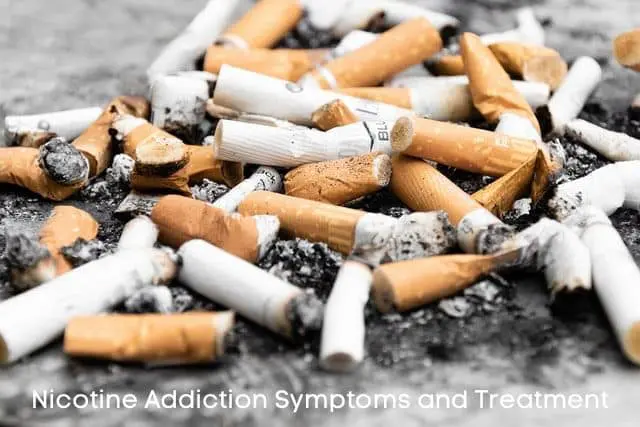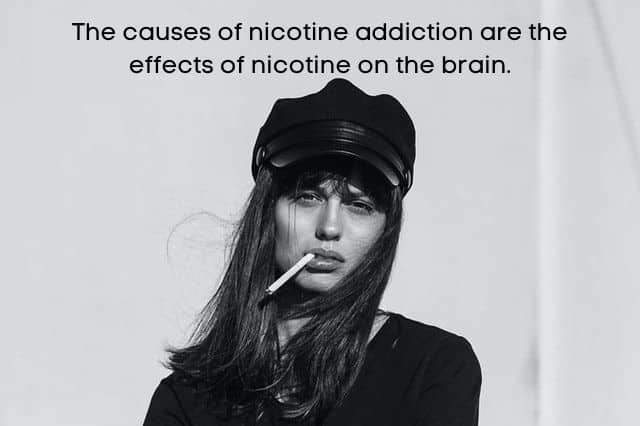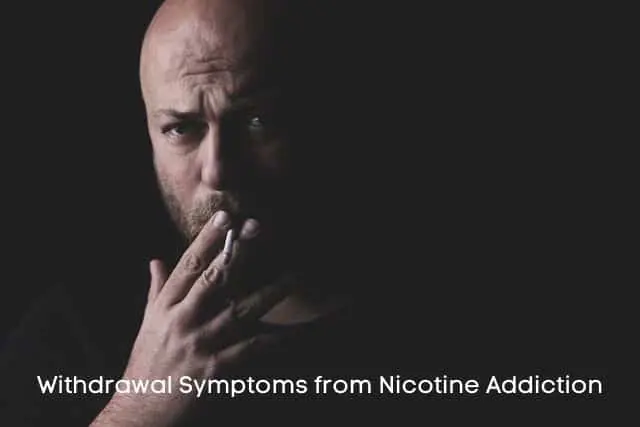Nicotine addiction symptoms and treatment

Nicotine addiction is one of the most prevalent types of addiction. However, the use of tobacco products is largely normalized. As a result, the exact scope and dangers of nicotine addiction are overlooked.
The symptoms of nicotine addiction include an inability to stop using tobacco products, experiencing withdrawal symptoms when nicotine use stops, a desire to keep smoking even when health complications arise, and continued use of tobacco products even if it negatively impacts your life.
Treatment for nicotine addiction typically involves a combination of counseling and nicotine replacement therapy, but others opt for natural approaches. These include acupuncture, hypnosis, essential oils, and herbs.
What are the causes of nicotine addiction?
The causes of nicotine addiction include genetics, family history of tobacco use, social and peer influences, early first use of cigarettes and other tobacco products, and co-occurring mental health disorders.
Nicotine is the main ingredient that makes tobacco addictive, and it reaches the brain seconds after a person takes a puff of a cigarette. When it reaches the brain, nicotine increases the release of dopamine, which regulates mood and behavior.
Dopamine is involved in the brain’s reward system. With continued use, the expression of dopamine receptors decreases. For that reason, a person needs to smoke more and more in order to achieve or maintain pleasurable effects.
Various factors contribute to the development of nicotine addiction. The causes of tobacco addiction are listed below.
- Genetics
- Growing up with parents and other family members who smoke
- Socializing with people who smoke or use tobacco drugs
- Smoking cessation products such as patches, lozenges, and gums
- Early first use of cigarettes and other tobacco products (childhood or adolescence)
- Substance use
- Mental health illnesses such as depression

What are the possible symptoms of nicotine addiction?
Possible symptoms of nicotine addiction include a variety of physiological and behavioral markers linked to the regular consumption of substances containing nicotine. The possible symptoms of nicotine addiction are listed below:
- Inability to stop using tobacco products
- Withdrawal symptoms when nicotine use stops
- Desire to keep smoking even when health complications arise
- Continued use of tobacco products even if it negatively impacts your life
1. Inability to stop using tobacco products
An inability to stop using tobacco products refers to the persistent and challenging difficulty that individuals face in discontinuing or reducing their consumption of substances containing tobacco. The hallmark sign of tobacco addiction is the inability to stop using tobacco products. Quitting smoking is particularly challenging.
What makes a person unable to stop using tobacco products is the effect of nicotine on the brain. As the main drug in tobacco, nicotine stimulates the brain. In turn, the brain gets used to having nicotine around. With continued use, nicotine changes how the brain works and makes it appear like nicotine is necessary to feel okay. As a result, a person with nicotine addiction isn’t able to stop using tobacco products that easily. This explains why fewer than one in 10 adult smokers succeed in quitting each year, according to the 2022 fast facts on smoking cessation from the Centers for Disease Control and Prevention (CDC). The main reason for this is that numerous smokers try to quit on their own, without professional help. The good news is that three out of five adults who have ever smoked cigarettes have quit.

2. Withdrawal symptoms when nicotine use stops
Withdrawal symptoms are physical and psychological effects that occur with abrupt discontinuation of a drug or substance, in this case, nicotine. More precisely, withdrawal symptoms occur when a person suddenly stops smoking cigarettes.
The body and brain adapt to the nicotine taken regularly. As a result, they expect a certain level of nicotine every day. When a person tries to quit smoking or chewing tobacco, the body and brain don’t receive nicotine and react unpleasantly.
Nicotine withdrawal symptoms usually start within 30 minutes or a few hours after the last dose of nicotine. The symptoms peak in intensity on day two or three. The duration of withdrawal varies from one person to another. In most cases, nicotine withdrawal symptoms persist for a couple of days to a few weeks, an article titled, “Nicotine Withdrawal” last reviewed in October 2021 by Cleveland Clinic explains.
The most common withdrawal symptoms in nicotine addiction include strong cravings for nicotine, nausea, headache, dizziness, and feeling anxious, irritable, and angry.
Other withdrawal symptoms include frustration, sadness, depression, difficulty sleeping and concentrating, tiredness, restlessness, boredom, increased appetite, and weight gain. Certain people have constipation or diarrhea, dry mouth, cough, sore throat, nasal drip, and chest tightness.Tingling in the hands and feet, sweating, and abdominal cramps are additional withdrawal symptoms of nicotine addiction.

3. Desire to keep smoking even when health complications arise
The desire to continue smoking even when health issues occur characterizes an individual’s continuous desire to continue smoking despite experiencing harmful health impacts directly related to tobacco usage.
Smoking causes cardiovascular diseases and events such as abdominal aortic aneurysm, coronary artery disease, cerebrovascular disease, and peripheral arterial disease. Nicotine addiction leads to high blood pressure and further contributes to atherosclerosis, heart attack, and stroke.
A fact sheet titled, “Health Effects of Cigarette Smoking” last reviewed in October 2021 from the Centers for Disease Control and Prevention (CDC) reported that smoking increases the risk of coronary artery disease and stroke by two to four times.
Nicotine addiction is disastrous for the lungs too. Men and women addicted to nicotine are at risk of developing acute lung diseases such as pneumonia and chronic lung diseases such as chronic obstructive pulmonary disease (COPD) and emphysema. In fact, the same article from CDC added that smoking causes 80% (or 8 out of 10) of all COPD-related deaths.
Not only does nicotine addiction jeopardize every organ in the body, but it increases the risk of various cancers. These include lung cancer, acute myeloid leukemia, bladder and kidney cancers, gastrointestinal cancer, cervical cancer, pancreatic cancer, breast cancer, and laryngeal, pharyngeal, and esophageal cancer. Additionally, nicotine addiction increases the risk of cancer recurrence.
Smoking causes 90% of all lung cancer-related deaths. Female smokers are 25.7 times more likely to develop lung cancer than their nonsmoker counterparts. Male smokers are 25 times more likely to get lung cancer.
Nicotine addiction leads to reproductive conditions such as impotence and sperm abnormalities in men, infant mortality, fertility struggles in women, and poor pregnancy outcomes.
Additionally, an article titled, “Nicotine Dependence” from the University of California San Francisco reported that smoking contributes to other conditions such as cataracts, peptic ulcer disease, osteoporosis, periodontitis, and gum disease.
The consequences of nicotine addiction extend to the individuals around the smoker. Exposure to secondhand smoke leads to ear problems, acute respiratory infections, and more severe asthma.Even when addiction to nicotine puts a person’s health in danger, affected individuals continue to smoke cigarettes. This behavior is one of the telltale signs of problematic substance use.

4. Continued use of tobacco products even if it negatively impacts your life
Continuing use of tobacco products even if it negatively impacts one’s life is a behavioral pattern characterized by the persistent consumption of tobacco despite the recognition of adverse consequences. When someone struggles to reduce or give up smoking despite knowing that it is negatively impacting various areas of their life, it is frequently a sign of a substance use disorder.
Even when they’re aware of the negative effects of their problem, they are still reluctant to stop. Several people decide to quit, but usually give up due to withdrawal symptoms.
Addiction to nicotine exhibits negative effects on a person’s appearance. For example, it speeds up aging, the formation of fine lines and wrinkles, causes uneven skin tone, and age spots. Smoking cigarettes contributes to sagging skin, arms, and breasts, and accelerates the formation of fine lines around lips.
Nicotine addiction damages teeth and gums, stains fingers, and contributes to hair loss. These changes in appearance decrease confidence and self-esteem. That way, nicotine addiction affects a person’s quality of life. Due to low confidence, an affected individual isn’t motivated to make positive changes in work or at home.
Additionally, being addicted to nicotine harms relationships. Family and friends who are nonsmokers often confront a person with nicotine addiction and express concerns about their behavior. Since the addicted person is in denial, they become argumentative and hostile toward other people.
In fact, according to a 2019 poll that Povaddo conducted for Philip Morris International (PMI), seven out of ten individuals report having marital problems as a result of their partner’s smoking. Nevertheless, despite being conscious of the detrimental effects their addiction has on relationships, smokers persist in their habit. Aside from the resulting relationship struggles, smoking addiction additionally affects a person’s life in other ways. For example, nicotine addiction decreases productivity at work or school, especially if the person sneaks out to smoke. They continue doing so even when their manager or coworker reprimands them about their behavior.

What are the available treatments for nicotine addiction?
Available treatments for nicotine addiction include medications and counseling. In most cases, these methods are used in combination. For example, patients receive nicotine replacement therapy to reduce cravings and effects of nicotine withdrawal, but they additionally need counseling to cope with addiction and learn to overcome it.
Behavioral therapies help a patient identify negative thoughts and behaviors to replace them with positive patterns. Patients learn to resist the urge to have a cigarette and find a healthier way to cope with stress, express their emotions, and feel relaxed.
In fact, according to a review by Choi et al., published in the July 2021 issue of the Cleveland Clinic Journal of Medicine, in adolescent cigarette smokers, nicotine replacement therapy (NRT) paired with cognitive-behavioral therapies has been demonstrated to be beneficial. However, further study is required to discover the most effective treatment for nicotine addiction in adolescents, particularly when it is linked with e-cigarette usage.
Alternative treatments are useful, but it is vital to focus on their quality. In several cases, a combination of standard and alternative treatments works best.
The alternative nicotine addiction treatments are listed below.
- Hypnosis
- Acupuncture
- Herbs
- Essential oils

1. Hypnosis
Hypnosis is a trance-like state wherein a person’s focus and concentration are heightened. As a popular method to quit smoking, hypnotherapy helps patients to focus on their own resources to decrease cravings.
This approach promotes the treatment of nicotine addiction, thanks to its relaxing effects. The Addictive Behaviors Reports published a study by Bollinger et al., in 2020 that showed that subjects who received hypnotherapy had lower cravings scores.
What makes hypnosis beneficial is that it makes people more relaxed and concentrated. In this state, they are more willing to listen to suggestions like giving up cigarettes and tobacco products.
Even though a person appears like they’re in a trance during hypnosis, they are not unconscious. When hypnotized, a person is still aware of their surroundings.
While there are several hypnosis methods for nicotine addiction, Spiegel’s method is the most well-known. This particular method focuses on three ideas or affirmations that hypnotherapists ask patients to repeat. One idea is that smoking poisons the body whereas the other idea confirms a person needs their body to live. The third idea is that every person needs to respect their body and protect it.
2. Acupuncture
Acupuncture is a type of alternative medicine that involves the insertion of thin needles through specific points on the body in order to promote relaxation, aid in pain relief, and improve energy.
While extensive research on this subject is necessary, a 2019 paper by Wang et al., published in Tobacco Induced Diseases showed that acupuncture helps treat nicotine addiction. The study added that acupuncture is particularly effective when combined with other treatment options.
In order to treat nicotine addiction, an acupuncturist targets specific areas such as pressure points in the ears. This stimulates the nervous system to suppress cravings for nicotine and reduce the intensity of withdrawal symptoms. After acupuncture, a person with nicotine addiction has fewer cravings, better mood, reduced irritability, better sleep, and improved bowel movements.
Acupuncture is practiced in combination with other natural approaches such as hypnosis, herbs, and essential oils. Keep in mind that the effectiveness of acupuncture depends on the quality of a practitioner, so always choose wisely.

3. Herbs
Herbs are plants or plant parts that are prized for their aromatic, culinary, medicinal, or even decorative qualities. Herbs help treat nicotine addiction. For the best effects, the herbs are customized by a herbalist for each patient to address their specific needs. The main goal of herbal intake is to reduce withdrawal symptoms.
One of the most significant herbal remedies to curb cravings is green tea. Besides drinking tea, people take green tea supplements too. Not only does green tea reduce cravings for cigarettes, but supports overall health and reduces the risk of COPD as well.
Other herbal remedies for decreasing cravings are St. John’s wort and lobelia. Further research is necessary to elucidate their effects and identify other herbs that aid the treatment of smoking addiction.

4. Essential oils
Essential oils are compounds extracted from plants. They serve numerous purposes from beauty to medicinal. The use of essential oils and aromatherapy helps people with nicotine addiction reduce cravings and support their recovery.
A great example is black pepper essential oil which similarly stimulates the respiratory system as cigarette smoke and thereby helps curb the urge to smoke.
In addition to black pepper, other essential oils that reduce cravings and withdrawal symptoms of nicotine addiction include angelica essential oil, lavender essential oil, peppermint essential oil, sweet orange, rosemary, and roman chamomile essential oils.
Certain essential oils work just like black pepper e.g. angelica essential oil. Others work through stress relief and relaxation.The best way to use essential oil to reduce withdrawal and cravings is through inhalation. They are used in diffusers, candles, inhalers, and vaporizers.


